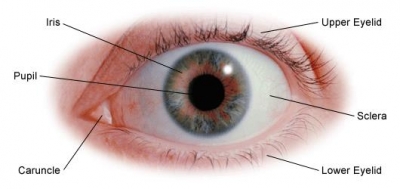
The pupil is the opening in the center of the iris (the structure that gives our eyes their color). The function of the pupil is to allow light to enter the eye so it can be focused on the retina to begin the process of sight.
Together, the iris and pupil control how much light enters the eye. Using the analogy of a camera, the pupil is the aperture of the eye and the iris is the diaphragm that controls the size of the aperture.
The size of the pupil is controlled by muscles within the iris — one muscle constricts the pupil opening (makes it smaller), and another iris muscle dilates the pupil (makes it larger). This dynamic process of muscle action within the iris controls how much light enters the eye through the pupil.
In low-light conditions, the pupil dilates so more light can reach the retina to improve night vision. In bright conditions, the pupil constricts to limit how much light enters the eye (too much light can cause glare and discomfort, and it may even damage the lens and retina).
Picture Credit : Google

